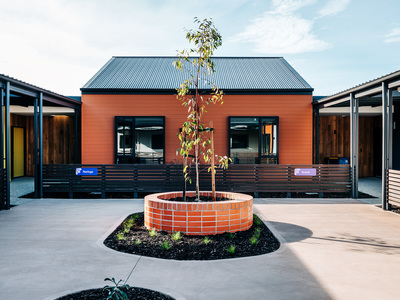Korongee Village: a new era in dementia care

When Korongee Village officially opened its doors in July this year, it marked the beginning of a new era in dementia care in Australia.
The world-class facility is based on a small house model design and utilises a tailored matching process for house selection of new residents. This tailoring, which has been developed in conjunction with the University of Tasmania, will address the challenges of institutional care and lead to increased social engagement opportunities and enhanced wellbeing for residents.

A questionnaire and interview process — with the resident and their loved ones — helps staff to determine which of the six identified typologies represents the person’s way of life before they came to residential care. They will then be placed in a house with people who share the same values.

Glenview CEO Lucy O’Flaherty said Korongee is a game changer in addressing the big social challenges of dementia.
“This is an opportunity with a brand new site to create something special,” she said.
“The entire village has been built with dementia design principles throughout, so a sense of everyday familiarity is much easier to maintain.”
The village is situated in the northern suburbs of Hobart and features 12 houses in four cul-de-sacs along with the heart of the village, consisting of a community centre, gardens, a general store, cafe and a wellness centre.

The unique design of Korongee, and the way its residents are cared for, is centred on evidence that supports small house living. An important element of this model is the inclusion of familiar sights and natural spaces, which can have a huge impact on overall happiness, health and wellbeing.
Because of this, the landscape and built environment of Korongee reflects dementia design principles, providing residents with visual cues to help them easily find their way around the village grounds. This includes differently coloured houses with distinctive painted doors and planter boxes.

The same staff members are also assigned to each household so that residents see familiar faces every day, and the houses are equipped with lighting systems that imitate the pattern of the sun.
Each of the village’s houses contains eight private bedrooms for residents, plus its own living and dining area, as well as a kitchen for preparing and serving meals. Other details, like glass-panelled ‘memory boxes’ at the entrance of each bedroom for displaying important personal mementos, are designed to help each resident feel at home.
“The design of Korongee has been created from its inception with careful consideration of research, technology and dementia design in both internal and external environments, as well as calling upon known and emerging good practice themes,” O’Flaherty explained.

Industry super fund HESTA has invested $19 million into the Korongee project through a Social Impact Investment Trust. HESTA CEO Debby Blakey said the opening of Korongee represents a significant milestone for aged care in Australia.
“As the industry super fund for the health and community services sector, we’re incredibly proud to partner with Glenview on this project and support innovation in dementia care. Korongee is a huge step forward for dementia care in this country and puts Australia and Tasmania at the forefront of a global push to improve the quality of life of those living with dementia,” Blakey said.
“We also hope our investment in this very important project encourages other large investors to contribute to Australia’s impact investment market, which will help address significant social challenges like dementia and also create jobs and opportunities for our members who work in health and community services.”
Director of the Wicking Dementia Research and Education Centre James Vickers said that with dementia emerging as the most important health issue of the century, the rapidly rising prevalence of this condition would have tremendous impacts across our society.
“It is vitally important to reconfigure our approach to care in order to meet the needs, as well as support the dignity and autonomy, of people living with dementia now and into the future,” he said.
O’Flaherty said the long-term plan is to generate enough evidence around the village’s unique model of care that broader lessons can be shared with the wider Australian aged-care sector.
“If solid, reliably drawn data and analysis suggests changing someone’s environment substantially improves their quality of life, I believe there will be a greater appetite to invest in village-based models of care.”
Quick facts: dementia*
- Approximately 459,000 Australians are living with dementia, with almost 1.6 million Australians involved in their care.
- Dementia describes a collection of symptoms that are caused by disorders affecting the brain. It is not one specific disease.
- Dementia affects thinking, behaviour and the ability to perform everyday tasks. Brain function is affected enough to interfere with the person’s normal social or working life.
- Dementia can happen to anybody, but it is more common after the age of 65 years. People in their 40s and 50s can also have dementia.
*Source: Dementia Australia
Fundamental reimagining: new Sydney Children's Hospital, Randwick
The new Sydney Children's Hospital, Randwick, was designed as a fundamental reimagining of...
UNSW Health Translation Hub opens
The $600 million UNSW Health Translation Hub — an integrated medical, research and health...
Vertical healing: redefining health care through high-rise hospital design
The high-rise hospital signifies more than a shift in form — it reflects a transformation...

![[New Zealand] Transform from Security Awareness to a Security Culture: A Vital Shift for SMB Healthcare — Webinar](https://d1v1e13ebw3o15.cloudfront.net/data/89856/wfmedia_thumb/..jpg)
![[Australia] Transform from Security Awareness to a Security Culture: A Vital Shift for SMB Healthcare — Webinar](https://d1v1e13ebw3o15.cloudfront.net/data/89855/wfmedia_thumb/..jpg)




